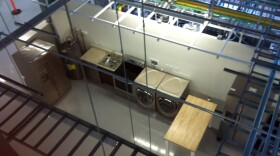What comes to mind when you think about milk? Like it or loathe it, you probably associate it with cereal, Oreos and milk mustaches. One thing you probably don't think about? Energy.
It turns out, it takes a lot of energy to make a gallon of milk. Recently, a few Colorado dairymen have been working to lighten their milk's energy load.
Jim McClay is one of these energy-obsessed dairymen. Dressed in a hoodie, jeans, and a baseball cap, the owner of Cottonwood Dairy enthusiastically spouts terms like "carbon footprint" and "T-5 light fixture," when speaking about efforts to improve efficiency at his dairy.
Instead of having Coloradans drive by his dairy and saying "ooh, that smells," McClay said, "I want them to say, 'Wow, this facility is producing milk using half the energy they did 10 years ago, and they are producing more milk.'"
McClay's Weld County dairy is on the small side for a Colorado farm -- he milks about 320 cows -- the state average is 1,200.
Even with its relatively small size, he goes through a lot of electricity. While national data on dairy energy use doesn't exist, the National Sustainable Agriculture Information Service says dairies use more energy than almost any other agricultural operation.
That's because there are a lot of steps involved in getting milk out of a cow and into a store. At the dairy level, the big energy uses are for pumping milk away from the cow, lighting and ventilation, and cooling the milk.

Milk comes out of a cow at about 99 degrees. When the truck comes to pick that milk up, though, it needs to be just a few degrees above freezing. Getting it there takes a lot of electricity.
The milk also has to get pumped from the cows to the cooling tanks. Sucking away 26,000 pounds of milk a day – the amount produced at Cottonwood -- takes a lot of power. And then, since everything on the dairy has to be food-grade clean, McClay uses a whole lot of energy heating water to 180 degrees so he can sterilize his equipment and barn.
"Electricity-wise, we use about the same as 10 households a month. If your normal bill is $200, ours is $2,000," he said.
McClay was able to cut his electricity use by over 25 percent with help from a new program offered by the Colorado Energy Office. The program is focused on helping dairies and irrigators, two big energy users, lighten their energy load.
"Dairies tend to be energy-intensive. They operate 24-7, 365 days a year," said Christian Williss, the man at the helm of the energy office's program.
The program was in a pilot phase for 2014, and worked with eight dairies. So far it's saved 260,000 kilowatt-hours of electricity a year -- enough to power 24 homes. When it goes statewide, Williss expects to save 10 million kilowatt-hours over three years.
Here's how it works: A dairy signs up and gets a free energy audit. The auditors spend half a day at the dairy investigating its current energy use. A few weeks later, they come back with a set of recommendations.
For McClay, this was an eye-opener.
"You'd be amazed how much stuff you've been operating on for the last 20 years or 10 years that is not efficient at all," he said.

Remember that 99-degree milk? McClay had long wanted to install some newer equipment, like a plate cooler, which pumps water alongside the milk, to help speed up the chilling. But it was always too expensive.
"This afforded us the opportunity to experiment at a much lesser financial risk," he said. Gesturing toward the plate cooler, what looks like an unassuming metal box inside his clean, well-lit barn, McClay explained how.
"This is taking enough heat off so now the milk is going into the tank constantly at about 65 degrees."
It used to take him 8 hours to cool his milk in a giant metal tank. With the plate cooler working in concert with the tank cooling, it's a two-hour process. His electric bill shows the difference.
McClay and other dairies in the pilot program found other ways to save energy too, from installing more efficient lighting to improving how they heated water for cleaning, said the energy office's Williss.
For this first year, if the dairy decided to implement the recommendations, they only had to pay for 25 percent of the cost up to $25,000 in improvements – funding from the federal Department of Energy covered the rest. When the program goes statewide in 2015, the state energy office will continue providing free audits, and funds from the U.S. Department of Agriculture will help pay for some of the improvements.
Cindy Haren, president of the Western Dairy Association, which represents Colorado, Montana, and Wyoming dairymen, said the U.S. dairy industry has committed to reducing its greenhouse gas emissions by 25 percent by the year 2020.
"We really believe that the time is now for all of these types of projects," she said.
Over the past 70 years, dairies have constantly improved their efficiency. "Our cows are producing 400 percent more," she said. "So they are using 90 percent less land, they are using 77 percent less feed, and 65 percent less water."
Using less energy is just the logical next step.

At Jim McClay's dairy, the farmer tells a detailed tale outlining why he stopped using paper towels to wipe and sanitize the cows before and after milking.
"I figured we were using $4,500 to $4,800 a year in paper towels." So he bought a pair of washing machines for $750, and uses washable towels now. It's obvious McClay, a born tinkerer, is interested in tweaking what he can, always trying to save a little along the way.
Not all dairymen may be as enthusiastic to reduce waste as he is. With the state's energy office guiding them along the way, though, maybe they don't have to be.







